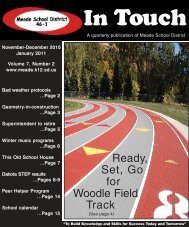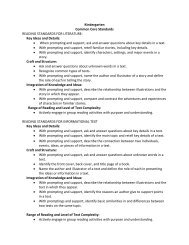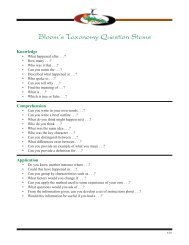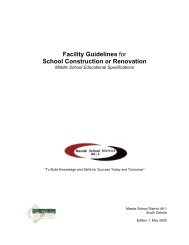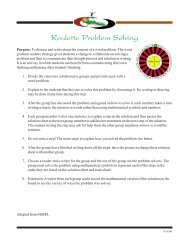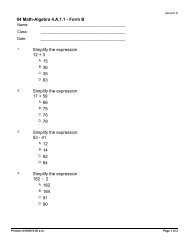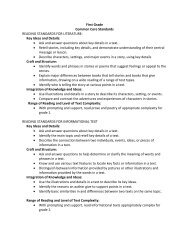Assessing Students' Affect Related to Assessment for Learning
Assessing Students' Affect Related to Assessment for Learning
Assessing Students' Affect Related to Assessment for Learning
Create successful ePaper yourself
Turn your PDF publications into a flip-book with our unique Google optimized e-Paper software.
<strong>Assessing</strong> Student’s <strong>Affect</strong> <strong>Related</strong> <strong>to</strong> <strong>Assessment</strong> <strong>for</strong> <strong>Learning</strong>W. James Popham and Rick StigginsSuggested Uses of the Inven<strong>to</strong>riesThese affective inven<strong>to</strong>ries are intended exclusively <strong>for</strong>teachers <strong>to</strong> use as instructionally relevant evidence-eliciting<strong>to</strong>ols in their classrooms, and only if a teacher individuallydecides <strong>to</strong> do so. The inven<strong>to</strong>ries are not designed <strong>for</strong>evaluative purposes at either the teacher-level or schoollevel.Indeed, as will be suggested later, the inven<strong>to</strong>ries arespecifically constructed so they can be modified <strong>to</strong> meshbetter with a particular instructional context and a giventeacher’s interests in students’ affect.If a teacher wishes <strong>to</strong> collect in<strong>for</strong>mation regardingshifts in students’ affect during the course of a school year,and want <strong>to</strong> submit such affective data <strong>for</strong> personnelevaluationpurposes, this would clearly be the teacher’schoice. The purpose of the three affective inven<strong>to</strong>riesprovided in the Appendix is <strong>to</strong> assist teachers in determiningwhether classroom implementation of AFL is having thedesired impact on students’ affect.One relatively simple and straight<strong>for</strong>ward use of anaffective inven<strong>to</strong>ry in an AFL class is <strong>for</strong> the teacher <strong>to</strong>administer it on a pre-instruction and post-instruction basis,<strong>for</strong> instance, at the beginning and end of an instructionalunit, a grading period, semester, or school year, dependingon the context. A contrast between such pre-instruction andpost-instruction results will allow a teacher <strong>to</strong> determine ifany meaningful improvements have taken place in, <strong>for</strong>example, students’ academic efficacy.However, because AFL teachers are typically attentive<strong>to</strong> the ongoing nature of instruction in their classes, thissuggests that a more fruitful use of these affectiveinven<strong>to</strong>ries would involve their administration several timesduring instruction. By so doing, of course, teachers wouldthen have time <strong>to</strong> make adjustments in what they weredoing based on class-focused inferences about students’affect and students’ reactions <strong>to</strong> what is taking place in class(with respect <strong>to</strong> the two statements about clarity ofexpectations and the two statements about progressmoni<strong>to</strong>ringin<strong>for</strong>mation). Care should be taken not <strong>to</strong>administer these inven<strong>to</strong>ries so frequently over a shortperiod of time that students become jaded about excessiveuse of the inven<strong>to</strong>ries.Still another approach might be <strong>to</strong> use the inven<strong>to</strong>riesstrategically. That is, if a teacher senses that things aren’tgoing well and students’ reactions <strong>to</strong> instructional activitiesare not sufficiently positive, responses <strong>to</strong> an inven<strong>to</strong>ry mightprovide some insight in<strong>to</strong> why this is the case. Results mightpoint <strong>to</strong> AFL actions teachers might take <strong>to</strong> get studentsback on track.Modifying the Inven<strong>to</strong>riesThese public-domain inven<strong>to</strong>ries are provided <strong>for</strong>teachers <strong>to</strong> use without restriction. There is nothingsacrosanct about the nature of the items in the inven<strong>to</strong>ries inthe Appendix, so teachers should feel free not only <strong>to</strong>modify the current items, but also <strong>to</strong> add or delete items. Forexample, if an elementary teacher happened <strong>to</strong> beparticularly interested in students’ interests in reading or,perhaps, in social studies, then statements such as thefollowing might be added <strong>to</strong> the items: “Lots of the time Iwould rather read than watch TV.” or “I really like it whenour class deals with social studies.” (Ideally, items shouldbe added in pairs so that one statement is phrased positivelyand another statement is phrased negatively.) Because theseinven<strong>to</strong>ries are intended <strong>to</strong> help an individual teacher do agood instructional job, teachers should modify theinstruments as they wish.Directions <strong>for</strong> AdministrationDuring our pilot-testing of early versions of theseinven<strong>to</strong>ries during their development, both teachers andstudents suggested that the Directions (<strong>to</strong> students) on theinven<strong>to</strong>ries themselves should be extremely brief, and thatthe teacher should give the bulk of the directions orally.There<strong>for</strong>e, as you will note on the inven<strong>to</strong>ries, the directions<strong>to</strong> the student are quite abbreviated. It is suggested that ateacher read (aloud) something along these lines <strong>to</strong> studentsprior <strong>to</strong> each administration of one of these affectiveinven<strong>to</strong>ries:Today I want you <strong>to</strong> complete a brief inven<strong>to</strong>rydealing with this class—and only this class. Youwill complete the inven<strong>to</strong>ry’s items anonymously,so just enter your responses—don’t put your nameon the inven<strong>to</strong>ry or write anything else. There willbe no way <strong>to</strong> tell how you responded, so pleaseanswer as honestly as you can. I will be using theaverage responses of the entire class <strong>to</strong> help me doa good job of teaching. That is the only reason Iam asking you <strong>to</strong> fill out this inven<strong>to</strong>ry.There is a sample of how you are <strong>to</strong> respond givenat the <strong>to</strong>p of the inven<strong>to</strong>ry. As you can see, you are<strong>to</strong> circle the response-letters <strong>for</strong> the itemsdepending on how you personally feel about eachstatement.When you are finished, please place yourcompleted inven<strong>to</strong>ry in the collection envelopethat has been provided. Thank you <strong>for</strong> helping mewith this.If the teacher is administering an inven<strong>to</strong>ry on morethan one occasion, there would be slight variations in thisset of oral directions such as, “Today I need you <strong>to</strong> oncemore complete the brief, anonymous inven<strong>to</strong>ry that you<strong>to</strong>ok several months ago, etc.”If there is a more appropriate way <strong>for</strong> students <strong>to</strong> returntheir inven<strong>to</strong>ries, such as by depositing the completedinven<strong>to</strong>ries in a collection box provided <strong>for</strong> that purpose,this <strong>to</strong>o would need <strong>to</strong> be noted. The idea of having theteacher supply oral directions <strong>for</strong> these inven<strong>to</strong>ries is thatthose directions can be suitably tailored <strong>to</strong> the teacher’sinstructional situation.This version released through The Council of Chief State School Officers3The FAST SCASS • Formative <strong>Assessment</strong> <strong>for</strong> Students and Teachers



